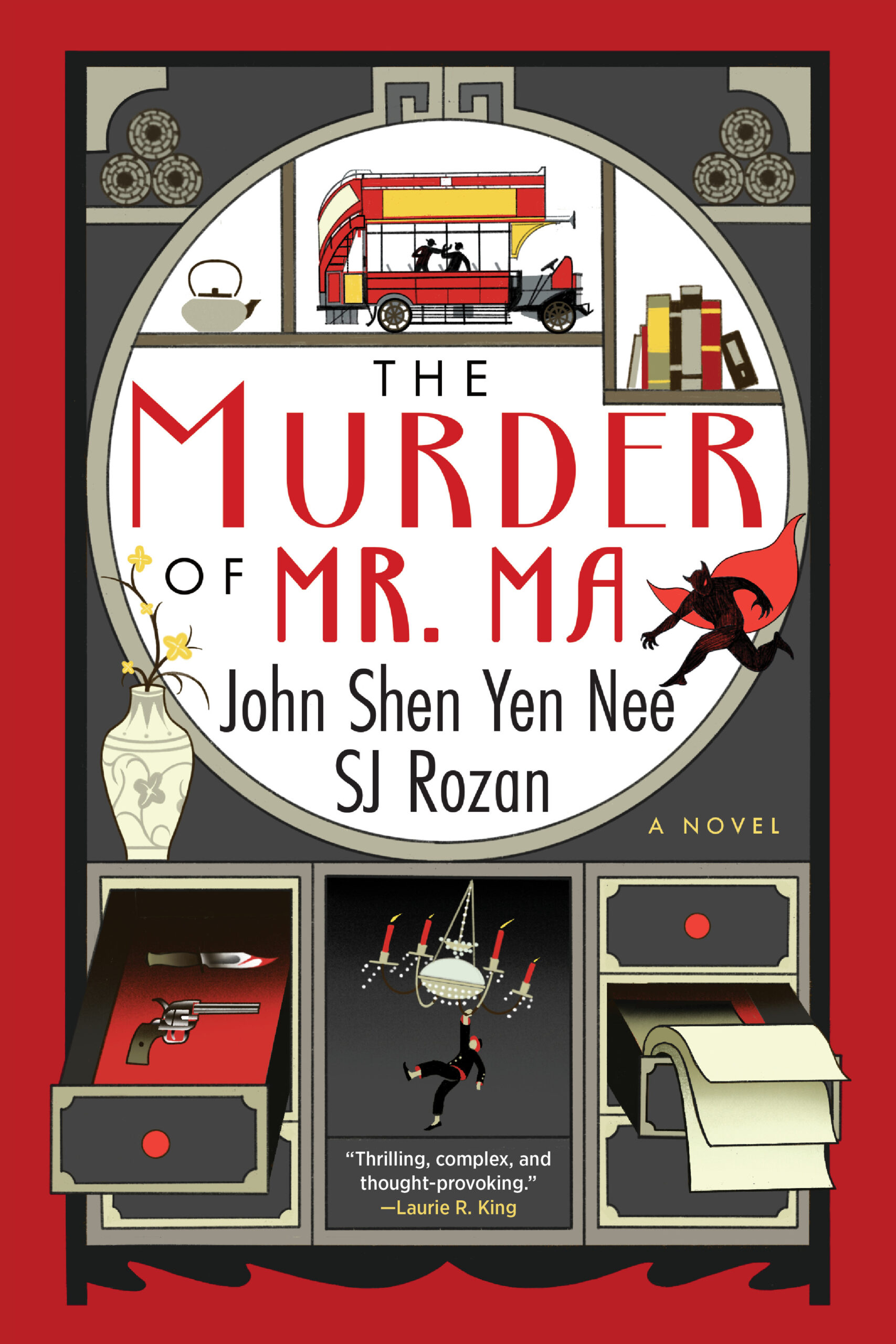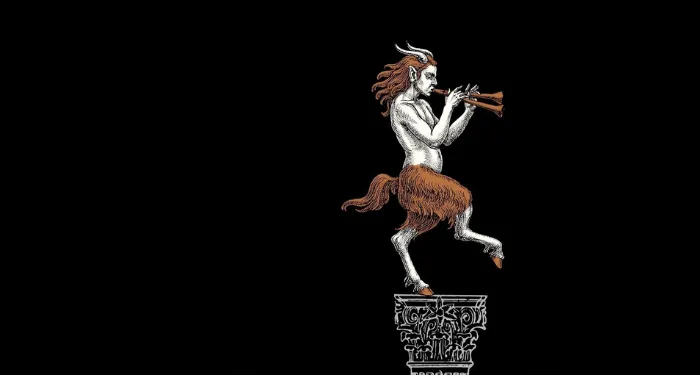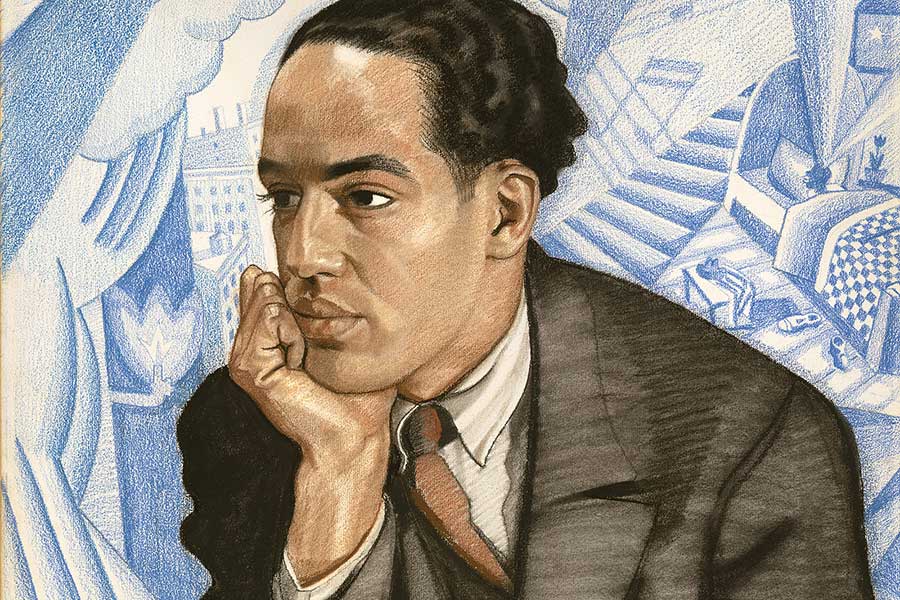The Murder of Mr. Ma by John Shen Yen Nee and SJ Rozan
What's It About?
Two unlikely allies race through the cobbled streets of 1920s London in search of a killer targeting Chinese immigrants.
What do you get when you combine two multi-talented creative minds that collaborate on an imaginative new series? This clever one is probably the best homage to Sir Arthur Conan Doyle’s iconic pairing of Sherlock Holmes and Dr. John Watson. Elementary, my dear reader, it is the hottest must-read murder mystery published in the spring of 2024.
The concept of The Murder of Mr. Ma (Soho Crime) was envisioned by John Shen Yen Nee and written in partnership with SJ Rozan. John is an entrepreneur and media executive, former Senior Vice President of DC Comics and former publisher of Marvel Comics.
SJ was a successful architect before switching gears from constructing innovative green structures to an esteemed author who plans and engineers elaborate, ingenious plot twists and engaging memorable characters. SJ Rozan swiftly built a career as a best-selling writer and editor who has been honored with every major detective/mystery fiction award including the Edgar, Shamus, Anthony, the Japanese Maltese Falcon and the Private Eye Writers of America Lifetime Achievement Award and has served on many national boards.
Detective Story With Humor and Suspense
The Murder of Mr. Ma is a masterpiece combining superb comic timing, thrilling swash-buckling fight sequences and the admirable deductive reasoning necessary to solve multiple murders of former members of the Chinese Labour Corps* who were part of a growing community of Chinese immigrants who settled in London after World War I. Paul Koh, a Kung Fu master, was brought in as a consultant to assist in choreographing action-packed martial arts sequences.
The result is an extraordinary literary mash-up of Holmesian styled detective story and traditional Chinese gong‘an crime case fiction you don’t want to miss! It takes place in London, England in 1924 during the reign of King George V. The scenes shift seamlessly between middle-class English drawing rooms and the shadowy underworld of a hidden Chinatown replete with underground restaurants unknown to most Londoners, as well as teahouses, curio and genuine antique shops and back alley opium dens.
The January 2023 issue of the bi-monthly long-running (since 1941) Ellery Queen Mystery Magazine featured a story called The Killing of Henry Davenport by John Shen Yen Nee and SJ Rozan that served as a prequel to this full-length novel and introduction to the book’s main characters Judge Dee Ren Jie and narrator Lao She as well as including the well-established Sherlock Holmes and Dr. Watson. They must solve a murder of an Englishman for which a Chinese man is falsely accused.
The Murder of Mr. Ma ramps up the action, cementing the friendship and working relationship of the two men. Judge Dee is the brilliant crime solver assisted by Lao She, the somewhat bumbling companion who documents the case notes for posterity.
London-Set Mystery with Unique Characters
Lao She narrates the tale as befits a shy academician and scholar employed by the University of London to teach Chinese to students aspiring to join the diplomatic corps and businessmen wishing to advance trade with China and the British Dependent Territory of Hong Kong. He is a lodger in the attic rooms of a modest home belonging to Mrs. Wendell, a very proper English widow who resides there with her lovely blonde, blue-eyed daughter Mary, whom he fervently and secretly admires.
The women were initially disdainful and fearful of Chinese “Yellow Devils”; reluctant to rent to Lao She until persuaded by Reverend Robert Evans whom Mary aspires to marry. Reverend Evans reminded them of their Christian duty. This former missionary to China attempts to conceal his bigotry while considering many converts to be “Rice Christians” motivated to join the Church of England for its food and charity instead of faith. The Wendells are gradually won over by their tenant’s impeccable Western attire and fine manners as well as his acquaintanceship with the Honorable Bertrand Russell.
The Murder of Mr. Ma begins when Mr. Russell summons Lao She to his home to affect a jailhouse rescue of Judge Dee, erroneously arrested by the Metropolitan Police, before its Inspector William Bard discovers he has been detained. Bard had previously been a British Army captain with whom Judge Dee had frequently clashed. During the war, Dee had been assigned by the Chinese Legation to mediate disputes between Chinese laborers and the British regulars on the frontlines. While nearly always appropriate, his decisions made enemies, chief among them was Bard.
Mr. Ma had been one of these WWI trench laborers, now in London and causing additional antipathy for having married a Caucasian English woman. He is the first to die by a distinctive ceremonial butterfly sword. The subsequent victims, all of whom served together in WWI, are killed in the same manner. Judge Dee becomes the consulting detective with Lao She observing and participating as needed. Valuable assistance is also provided by his faithful friend, former Sergeant Hoong Liang.
Chase Scenes and Martial Arts
They are determined to catch the murderer despite Inspector Bard’s reluctance to investigate crimes perpetrated on the lowly Chinese. The excitement mounts along with frenetic chase scenes and startling displays of martial arts.
Lithe, agile and bat like in his ability to leap great heights and distances, the Judge is an uncanny opponent worthy of all comers as well as being a master of disguise. He soon employs a skinny young pickpocket named Jim Finney aka “Jimmy Fingers” and his associates to gather information and convey it back to him as well as forming other useful alliances.
Fans of Sherlock Holmes stories will thoroughly enjoy finding references embedded throughout the pages of this innovative new series. Sir Arthur Conan Doyle, with his interest in the occult, would likely have been pleased by Judge Dee’s connection to the Spiritual World beyond the grave through his visions of and instructions from the long dead Commissioner Lin Tse Shu.
The Murder of Mr. Ma by co-authors John Shen Yen Nee and SJ Rozan is an outstanding work of fiction that will leave readers asking when Book 2 in the series will be published….not soon enough!
History of Gong’an Crime Fiction
Gong’an crime fiction involving judges or magistrates who solve cases originated in the Imperial Song dynasty which ruled China from 960 to 1279 CE. Judge Dee or Di stories were among the most popular in this genre. He is loosely based on Di Ren Jie, a magistrate and statesman from the earlier Tang Dynasty court, roughly 630-700 CE.
Robert van Gulik (1910-1967), a Dutch diplomat, Chinese scholar and former Ambassador to Japan, rediscovered and translated classic Chinese tales about Judge Dee. He perpetuated this revival by writing over 20 original novels about the magistrate/detective beginning in 1949 and continuing throughout the 1950’s. More recently Hong Kong film director Tsui Hark, a University of Texas-Austin graduate, has created a Detective Dee kung fu action-packed film series.
Lao She is also a fictionalized creation of a real person, albeit one born some 1200 years after Judge Dee. He was a Manchu intellectual named Shu Qing Chun born in 1899 during the Boxer Rebellion. He was a scholar, lecturer and school administrator as well as a novelist and playwright who deeply admired Charles Dickens. He received a US State Department-sponsored cultural grant in March 1946 to the United States where he traveled, supervised the translation of several of his novels and lectured.
Best-selling novelist Pearl S. Buck and her husband who had served as sponsors attempted to dissuade him from returning to China after the People’s Republic of China was formed in October 1949. Mrs. Buck had translated his novel Rickshaw Boy which had become a best-seller in the USA before they met. Unfortunately, he ignored their advice and experienced brutal mistreatment and torture aimed at intellectuals during the Cultural Revolution. His death by drowning on August 24, 1966 was either by murder or suicide.
Footnote on The Chinese Labour Corps
*The Chinese Labour Corps was the forgotten army of voluntary, non-combatant workers sent primarily to Britain and France with some to Russia beginning in 1916. Estimates range from 25,000 to 145,000 workers dispatched, most coming from the coastal province of Shandong. Over 20,000 died, many buried in uncommemorated common graves.
Officially neutral China was forbidden from sending combat troops but wished to be represented at future peace talks as a world power. These labour battalions consisting primarily of peasant farmers, some idealistic students and intellectuals were transported from China across the Pacific Ocean to Vancouver, Canada, and then sent by train to Halifax and across the Atlantic Ocean and on to the Western Front. Many died in transit, of disease or on troop ships sunk by German submarines.
On the front lines, they would provide essential logistical support, repairing tanks, maintaining equipment, transporting supplies and ammunition as well as digging foxholes and trenches and burying the dead. Some assisted in growing food for the troops. They did everything except fight in combat which was forbidden.
By the war’s end on November 11, 1918, these unsung and largely unacknowledged Chinese workers ranked as the largest non-European contingent in WWI. Great Britain recruited 94,500 and France some 37,000 workers who were earning money for their families at home in China. Many died or were badly injured.
In addition to serving in Europe, hundreds of graves of these Chinese laborers have been found in Basra, Iraq where they died carrying water to British troops. Postwar China established a Bureau of Overseas Chinese Workers receiving some compensation from the U.K. for the wounded. The number who remained in Europe post-war settling in London, Paris and other cities is uncertain.
The Chinese Labour Corps made an enormous difference in helping to win the war but were soon forgotten in peacetime. The 100-year Centenary of WWI in 2018 prompted rediscovery of their dedication and achievements when they were given some vastly overdue recognition.
About the Authors:
 John Shen Yen Nee is a half Chinese, half Scottish American media executive, producer and entrepreneur who was born in Knoxville, grew up in San Diego, and is now based in Los Angeles, with a penchant for very long run-on sentences. He has served as president of WildStorm Productions; senior vice president of DC Comics; publisher of Marvel Comics; CEO of Cryptozoic Entertainment; and cofounder of CCG Labs. (Photo Credit: Stan Prokopenko)
John Shen Yen Nee is a half Chinese, half Scottish American media executive, producer and entrepreneur who was born in Knoxville, grew up in San Diego, and is now based in Los Angeles, with a penchant for very long run-on sentences. He has served as president of WildStorm Productions; senior vice president of DC Comics; publisher of Marvel Comics; CEO of Cryptozoic Entertainment; and cofounder of CCG Labs. (Photo Credit: Stan Prokopenko)
 SJ Rozan SJ Rozan, a native New Yorker, is the author of 16 novels and six dozen short stories. Her work has won the Edgar, Shamus, Anthony, Nero, and Macavity awards for Best Novel and the Edgar for Best Short Story. She’s also the recipient of the Japanese Maltese Falcon and the Private Eye Writers of America Life Achievement Award. (Photo Credit: Charles Kreloff)
SJ Rozan SJ Rozan, a native New Yorker, is the author of 16 novels and six dozen short stories. Her work has won the Edgar, Shamus, Anthony, Nero, and Macavity awards for Best Novel and the Edgar for Best Short Story. She’s also the recipient of the Japanese Maltese Falcon and the Private Eye Writers of America Life Achievement Award. (Photo Credit: Charles Kreloff)

Publish Date: 4/2/2024
Genre: Crime, Historical Fiction, Mystery
Author: John Shen Yen Nee and SJ Rozan
Page Count: 312 pages
Publisher: Soho Crime
ISBN: 9781641295499



















 English (US) ·
English (US) ·